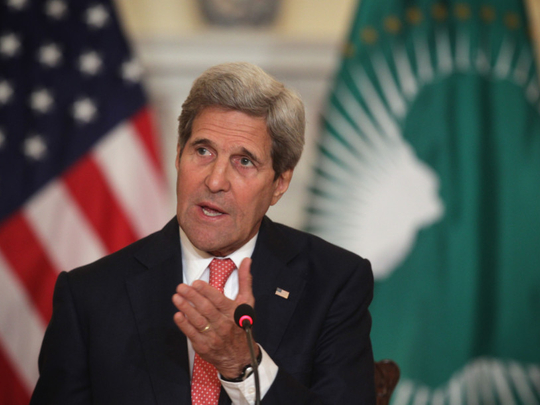
I joined US Secretary of State John Kerry’s negotiating team in late February, but throughout the negotiations, leading nuclear experts at the Energy Department and its national labs have been involved in the careful development and thorough evaluation of the technical proposals to help define US positions. As a result, the key parameters for the agreement that was announced on April 2 in Switzerland provide a technically sound path for certifying Iran’s nuclear program as peaceful, quickly determining if it is not and providing the breathing room needed to respond appropriately.
Iran has repeatedly emphasised its commitment to a peaceful programme, but today’s reality of national and UN sanctions highlights the international community’s concern about Iran’s past nuclear activity. The Lausanne understanding is not built on trust. It is built on hard-nosed requirements that would limit Iran’s activities and ensure vital access and transparency.
An important part of the parameters is a set of restrictions that would significantly increase the time it would take Iran to produce the nuclear material needed for a weapon — the breakout time — if it pursued one. The current breakout time is just two to three months. Under the JCPOA, that would increase to at least a year for at least 10 years, more than enough time to mount an effective response. The negotiated parameters would block Iran’s four pathways to a nuclear weapon - the path through plutonium production at the Arak reactor, two paths to a uranium weapon through the Natanz and Fordow enrichment facilities, and the path of covert activity.
To start, Iran would not have a source of weapons-grade plutonium. The Arak reactor would be redesigned and internationally certified to produce much less plutonium and no weapons-grade plutonium. In addition, we have agreed that all of the plutonium-bearing spent reactor fuel would be sent out of the country for the lifetime of the reactor. Any attempt to use the Arak reactor to produce weapons-grade plutonium would be easily detected.
Furthermore, for the indefinite future, Iran would have no capability to extract plutonium from spent fuel from any reactor and conduct no research and development on such reprocessing. No other heavy-water reactors, a type often associated with weapons programmes, would be built for at least 15 years, and any excess heavy water would be sold off. This framework shuts down the plutonium pathway.
Stockpile limitation
To block the pathways to a uranium weapon, Iran would reduce the number of operational centrifuges at Natanz to just over 5,000, from a current national inventory of almost 20,000 — and for a decade its only operational centrifuges would be IR-1s, Iran’s oldest and least capable model. When combined with a reduction in its enriched uranium stockpile from 10 tonnes to just 300 kilograms and enriched to less than 3.7 per cent, the time necessary to accumulate enough highly enriched uranium for a first bomb would match our requirement of at least a year for 10 years. It would take even longer to assemble a complete weapon. The uranium stockpile limitation would be in place for 15 years.
Additionally, for at least the first decade, there would be no R&D on a more advanced centrifuge model at the scale needed to confidently deploy that model for production.
Iran would no longer use the underground Fordow facility to enrich uranium or conduct uranium enrichment R&D; in fact, no uranium would even be allowed at the facility. Nearly two-thirds of the centrifuges and infrastructure would be immediately removed, with just more than 10 per cent of the centrifuges left operational. Furthermore, over time these centrifuges would be transitioned to non-uranium activities, and Fordow would become a physics research and medical isotope centre. The monitoring provisions of an agreement would easily detect any misuse of the facility.
The fourth pathway would be to produce enough fissile material for a weapon through covert means. We counter that pathway with unprecedented safeguards and access to not just enrichment facilities, but also to the full uranium supply chain, from mines to centrifuge manufacturing and operation. The uranium supply chain verification comes with a 25-year commitment.
Iran would quickly implement, and eventually ratify, the Additional Protocol to the International Atomic Energy Agency (IAEA) safeguards agreement. The Additional Protocol allows inspections and sampling at both declared nuclear facilities, such as Natanz, Fordow and Arak, and undeclared sites at which out-of-bounds activities are suspected. The IAEA would also be allowed to use advanced technologies to enhance continuous monitoring. This agreement is not for 10, 15 or 20 years; it is a phased agreement built for the long term. And if Iran earns the international community’s confidence in its peaceful objectives over this extended period, then the constraints will ease in phases, though its obligations under the Nuclear Non-Proliferation Treaty and the Additional Protocol would remain in place indefinitely.
Since the parameters were announced, there have been reports of differences between the fact sheets put out by the US and Iran. It is not surprising that Iran seeks to frame the debate over certain parts of the framework, but the parameters remain the same. And over the next few months, the US and its negotiating partners will continue to work towards a formal agreement with Iran.
No options for response — sanctions, diplomacy or other — are taken off the table. When combined with other political provisions in the framework for an agreement negotiated by Kerry and his partners, the recently concluded negotiation represents an important step towards a safer world.
—Washington Post
Ernest Moniz is US energy secretary.









